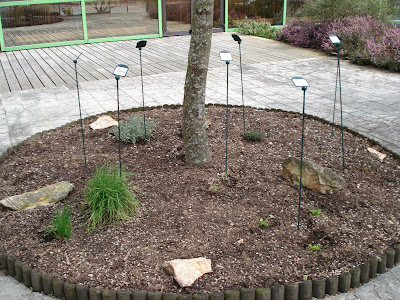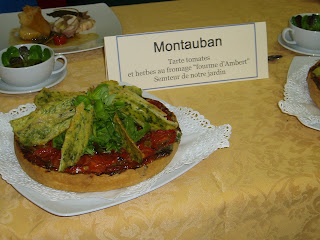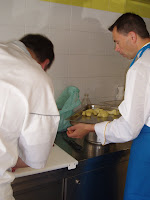lundi 10 novembre 2008
MONTAUBAN Novembre 2008
"Pavé de filet mignon de porc "Cul noir" au Corrézon rôti, sauce au miel et bière du Limousin, écrasée de pomme de terre et châtaignes aux noisettes".
A bientôt pour la fiche et les photos.
vendredi 20 juin 2008
Meeting in La Spezia (Italy)

1. ACTIVITIES DURING THE MEETING :
Visit of the catering section of La Spezia school
Visit of the garden of aromatic herbs “Comenius”
Meeting with the students and the teachers
Presentation of the work done by the students and the team of teachers during the school year.
Presentation of the blogs of the different schools
Preparation of dishes created by the students during the year
Tasting of these dishes by all the partners from a buffet prepared by the students of La Spezia.
Meeting with the press and television .
Visit of a fish keeping place
Visit of a mussel farm
Visit of Cinque Terre by boat
Visit of a wine cellar
Visit of the Organic Valley “ Val di Vara”.
Meeting with a producer of organic cheese and organic dairy products
Tasting of local products .
Meeting with vegetable producers and reception by the inhabitants of a village“Pignone”specialised in organic agriculture
2. ACTIVITIES IN 2007/2008
a) Meeting project in Almeria (Spain) : planning of the objectives of the year
b) Meeting project in La Spezia (Italie) : presentation of the activities and work achieved during the school year
c) Visit of food processing factories
d) Cultural visits
e) Creation of blogs and communication through them all along the year
f) Creation in each school of a garden of aromatic herbs, required by the objectives of the project
g) Creation by each school of a dish based on the use of local products and aromatic herbs
h) Preparation of some dishes from the different partners by the students in each school thanks to the recipe cards exchanged through the blogs .
i) Preparation of a glossary of technical words used in the different recipe cards
j) Preparation of a European Comenius evening in all the schools participating in the project .
k) Work on the geography of every country
3. DATES OF OUR NEXT MEETING IN MONTAUBAN
The next meeting will be held in Montauban in November 2008 from Monday 10th to Friday 14th . We will prepare the objectives for the year 2008/2009.(everyone can think about the possible activities .)
Each school will have to prepare a dish based on cheese and dairy products and aromatic herbs.
mardi 17 juin 2008
Travaux de printemps
mercredi 28 mai 2008
LA SPEZIA : The dishes presented. Plat présentés. Platos presentados.
samedi 17 mai 2008
Program of the meeting in La Spezia - 19 / 23 may 2008

19 May Monday
Arrival
Hotel del golfo Lerici
Via Gerini, 37 - 19032 Lerici (Sp) Tel. 0187967400 - 0187965733 Fax 0187965733
www.hoteldelgolfo.com
Dinner at Hotel del golfo
20 May Tuesday
9.00 Departure from Hotel del golfo to La Spezia IPSSAR G. Casini
9.30 Catering and hospitality college “quick” tour
10.00 Meeting : Working on the project
12.30 Lunch Prepared by IPSSAR G. Casini students.
Afternoon : Boat tour (military navy boat)
Departure from La Spezia to Mussel farming.
www.mitilicoltori.it
Tino and Palmaria islands. Portovenere
www.isolapalmaria.com
www.portoveneredidattica.it/sceLegrazie/Territorio/Portov_Imm/immagini_Porto_venere.htm
and Cinque Terre
www.cinqueterre.it
21 May Wednesday
9.00 at school : Working on the project
Preparation of a buffet : Each school has to prepare 1 dish.
12.30 Lunch
14.30 Wine Cellar Cantinae Lunae
www.cantinelunae.com/ita/home.htm
17.00 Visit Sarzana
Guided tour of the city centre.
19.00 Back to hotel
20.00 To Tellaro. A short walk through the fishing village narrow alleys , an aperitif and a super seafood dinner at Delfino Restaurant
http://www.borghitalia.it/html/borgo_it.php?codice_borgo=499
Delfino Restaurant www.ristorante-delfino.it/
22 May Thursday
9.00 Departure from Hotel del Golfo Lerici to Val di Vara.
Visit Varese Ligure village.
Wine Cellar Cinque Terre.
We will go to the famous Organic Valley.
Tour of the most important farms.
www.coopcasearia.it
Liguria's Secret Valley
Val di Vara - the Organic Valley
The Val di Vara is a little known part of Liguria which is gaining a reputation for good quality organic food.
I've just returned from Liguria. This part of Italy is best known for its stunning coastline, the Italian Riviera, but I stayed in the mountain region of the Val di Vara - a part of Liguria that has hardly been explored by tourists. It's an area that is well known in Italy however, as it has a reputation as a 'green' organic valley. The main town is Varese Ligure, once a resort for wealthy Genoese families escaping the heat and mosquitoes of the coast in summer. The whole area is making great efforts to be as green as possible: wind turbines and solar panels provide power, and waste is carefully recycled.
Many farmers in the valley raise their cattle organically, and the butcher's in Varese Ligure often has queues outside. There is also an organic cheese factory and organic yoghurt factory. Small producers in the valley also make honey - the chestnut one is particularly good . In the hill village of Castiglione Chiavarese, you can also find wine and olive oil at the Azienda Agricola Pinogino. The area, with its thick chestnut and beech forests, is also noted for its excellent porcini mushrooms.
www.cantinacinqueterre.com
20.30 Dinner : Prepared by the Evening classes IPSSAR G. Casini Students.
23 May Friday
Departure
mercredi 14 mai 2008
Sauge officinale

mardi 13 mai 2008
Verveine citronnelle
 La verveine citronnelle est une plante ligneuse de la famille des verbenaceae, de 1 à 3 m de hauteur. Originaire des Andes, où elle pousse entre 2 et 3000 m d'altitude, on la cultive aussi sur la côte du Pérou.
La verveine citronnelle est une plante ligneuse de la famille des verbenaceae, de 1 à 3 m de hauteur. Originaire des Andes, où elle pousse entre 2 et 3000 m d'altitude, on la cultive aussi sur la côte du Pérou.Elle est cultivée pour ses feuilles très parfumées au goût de citron, pour aromatiser sauces, marinades, gâteaux, crèmes et glaces.
Elle est aussi utilisée en liquoristerie dans la fabrication de liqueurs ou préparée en infusions aux vertus sédatives et digestives.
Son huile essentielle est utilisée en parfumerie.
Plante médicinale sans odeur, la verveine officinale, s'utilise en infusion ou en lotion.
Maxime E.Origan, marjolaine
Son nom d'origine grecque, signifie "joie des montagnes" car il aime l'altitude et les terrains secs et ensoleillés.
Elle fait partie de la famille des labiacées et compte une trentaine de variétés dont la plus célèbre est la marjolaine, aux feuilles plus petites et aux fleurs roses, d'un parfum pénétrant. Son parfum la rappoche du thym.
On les confond souvent mais l'origan est une variété sauvage de marjolaine.
L'origan change de parfum selon le climat et le sol où il pousse. Ses feuilles sont tendres et ses fleurs, roses ou blanches, pouss ent en grappes.
ent en grappes.
Utilisée fraîche ou sechée, elle agrémente les pizzas napolitaines et la moussaka.
On l'appelle aussi thym des bergers ou thé sauvage.
Laurie R.
dimanche 11 mai 2008
Ciboulette

La ciboulette est une plante aromatique de la même famille que l'oignon et l'ail. Ses tiges vertes, creuses et charnues poussent en touffes.
Couramment désignée sous le nom de "fines herbes", elle possède une saveur saveur plus fine et plus discrète que celle de l'oignon.
On l'appellait autrefois "civette"
Originaire de Chine, elle est très appréciée dans la cuisine du sud est asiatique.
Ses feuilles ont un goût alliacé ainsi qu'une teneur élevée en vitamine C.
Dans notre cuisine, elle s'utilise fraîche, finement ciselée pour relever salades, omelettes, fromages frais, mais on ne doit pas la réchauffer pour conserver sa saveur.
On peut aussi consommer ses bulbes émincés lorsqu'ils sont charnus.
Guillaume J.
vendredi 9 mai 2008
Mélisse officinale
La mélisse officinale ou mélisse citronnelle est une plante vivace de la famille des lamiacées.
Son nom grec, mélissophullon, signifie "feuille à abeilles"
Originaire de l'est du bassin méditerranéen, elle pousse facilement dans nos jardins, au soleil ou à l'ombre.
Il en existe plusieurs variétés :
- Mélisse dorée
- Mélisse lime
- Mélisse vietnamienne
- Mélisse panachée
L'eau de mélisse ou eau des Carmes, obtenue par distillation des feuilles possède des vertus antispasmodiques.
En fin de repas, ses feuilles infusées sont idéales pour la digestion.
En cuisine, sa saveur fraîche et citronnée, accommode viandes, poissons, salade de légumes ou de fruits. On peut aussi en faire des sorbets.
Certaines liqueurs l'utilisent dans leur composition telle que la Bénédictine (Fécamp, Normandie).
Mathilde G.
mardi 29 avril 2008
Jardin d'herbes aromatiques


Avec le retour du printemps...,et surtout l'aide de notre jardinier, notre jardin d'herbes aromatiques a pris place devant notre restaurant.
Il se compose de 9 plantes différentes, semées ou plantées :
-Persil,
-Sauge officinale,
-Ciboulette,
-Menthe,
-Verveine citronelle,
-Mélisse,
-Origan,
-Thym et
-Basilic
Les lapins s'en régalent mais ne sont pas attirés par la ciboulette et l'origan...
LE THYM :
Les deux variétés principales du thym sont :
*le thym méridional surnommé farigoule ou serpolet
*le thym d'hiver ou thym allemand (thymus vulgaris)
Le thym citron, aromatise agréablement les préparations mais ne supporte pas la cuisson.
Très utilisé en cuisine, le thym sert à aromatiser seul ou dans un bouquet garni. On peut l'utilser frais ou séché, dans le pot au feu, la potée, le casssoulet, les ragoûts et les poissons au four.
Frais, on peut relever les oeufs brouillés, les salades, le coulis de tomates....Il entre également dans la préparation d'infusions et de certaines liqueurs.
Tanguy D.
dimanche 27 avril 2008
Sélection

Ces trois plats étaient :
Filet mignon de porc en croustillant aux herbes, flan et sauce à l'oseille.
Canon d'agneau à la menthe, jus corsé au thym.
Râble de lapereau farci à la pomme et sauge, sauce au miel de bruyère.
Nous avons effectué la sélection finale sur deux séances, en répartissant le travail en deux groupes :
Le lundi 3 mars, un groupe a réalisé les trois recettes et l'autre groupe a procédé à la dégustation.
Pour nous aider dans la dégustation et l'analyse sensorielle du plat, nous disposions d'une fiche organoleptique. Cette fiche nous permettant de décrire nos sensations et nos observations.
Après celà, séance de synthèse, pendant laquelle chacun apportait ses critiques afin d'améliorer les 3 préparations.
Le 10 mars, le groupe qui avait dégusté, a réalisé les plats tout en apportant les modifications nécessaires sur les sauces, garnitures et présentations. L'autre groupe se chargeant de la partie la plus agréable, la dégustation !
Finalement,nous avons préféré le rable de lapin pour son moelleux et l'originalité de sa présentation. Nous avions modifié la préparation des pommes pour les présenter dans une feuille de brick afin d'apporter un élément croustillant.
La sauge, quant à elle, relève le lapin, tandis que le miel de bruyère, très aromatique, apporte un légère douceur, mais corsée, au jus.
Nous avons également revu l'appellation du plat pour le nommer :
"Râble de lapereau farci à la pomme du Limousin et sauge du jardin, jus au miel de bruyère. Craquant de golden rôti."
http://http//fr.wikipedia.org/wiki/Pomme_du_Limousin_%28AOC%29
With the help of our cooking teacher, we have decided to prepare 3 creatives dishes with 3 sorts of meat and herbs.
The dishes were :
Crisp loin of pork with herbs,flan and sorrel sauce.
Filet of lamb with mint and strong thyme meat juice
Saddle of young rabbit stuffed with apple and sage, heather honey sauce
We have carried out the final selection of the dish over 2 lessons, dividing the class into 2 groups for that work.
On monday 3 rd march, one group has achieved the 3 recipes and the other group has tasted the dish. To help us taste and analyse the dish, we had an organoleptic slip which enabled us to describe our feelings and observations.
After that, during a synthesis lesson, everyone could criticize the work so as improve the 3 preparations.
On 10 th march, the group that had tasted the dishes, achieved them making the necessary alterations on the sauces, the garnishes and presentations.
The other group did the most pleasant part of the work : the tasting !
Eventually, we selected the saddle of young rabbit for its mellowness and its inventive presentation. We had altered the preparation of the apples so as to present them in a brick leaf in order to bring a crisp element. The sage enhance the flavour of rabbit, whereas the other honey brings a light strong softness to the meat juice.
We have also altered the name of the dish to call it :
Saddle of young rabbit stuffed with apple from Limousin and sage from the garden, heather honey meat juice. Roast crunchy golden apple.
mercredi 12 mars 2008
mardi 19 février 2008
LOFOTEN in Limoges


A nuestros clientes les encantó este postre. Lo realizaremos de nuevo el 25 de febrero.
mercredi 30 janvier 2008
BUON APPETITO


Nous avons réalisé et servi une variante, crée par le lycée de la Spezia, les lasagnes Portofino.
Son originalité, bien loin des traditionnelles lasagnes avec tomates et à viande, était l'alliance de pommes de terres et de haricots verts, le tout relevée d'une béchamel parfumée au pesto et gratinée ensuite avec du fromage de brebis.
Que de soleil dans les assiettes à la plus grande satisfaction de nos clients !
Realizamos y servimos en nuestro restaurante una receta creada pour la escuela de La Spezia, las lasañas Portofino.
Lo original, muy lejos des las lasañas tradicionales con tomates y carne, era la mezcla de patatas y judías verdes con una salsa blanca (bechamel) perfumada al pesto y luego guisada al gratén con queso de cabra.
-Muy rico
- Original, me encanta el pesto.
¡ Mucho « sol » en los platos para la mayor satisfacción de nuestros clientes !El próximo lunes, descubriremos el postre de nuestros amigos de las islas Lofoten…
mardi 15 janvier 2008
Bientôt au restaurant...
Nous réaliserons la soupe de fruits des îles Lofoten (Norvège), les 4 et 25 février prochain.
A bientôt pour vous donner les impressions de nos clients !
BUON APETITO... !
NYT MAL TIDET.... !


























